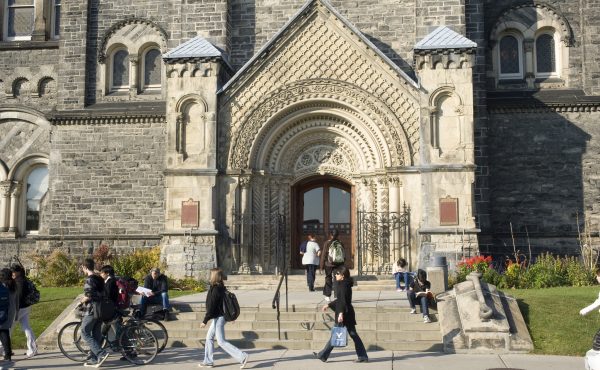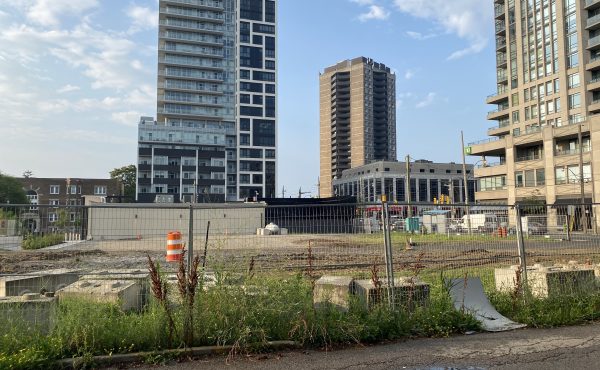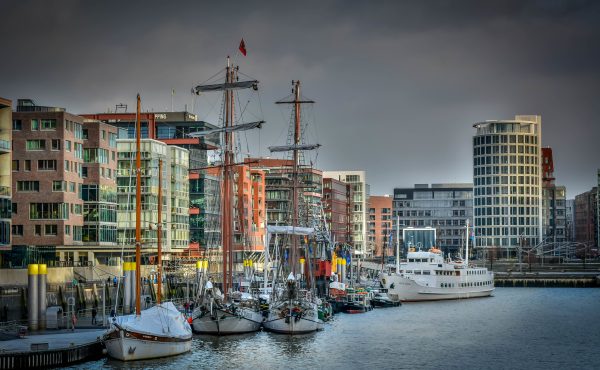
Just in time for Halloween, Tom Jakobek, Toronto’s most infamous undead politician, appeared at a community meeting last week to rally the locals against the bone-chilling prospect of a “big box” condo at the corner of Woodbine and Queen.
The former ward-heeler, who played a starring role in the MFP computer leasing scandal a dozen years ago, warned of a “crisis in planning” in the Beach, according to The Globe and Mail’s Elizabeth Church, who noted the growing chorus of objections to various Queen Street mid-rise projects, including the Lick’s site.
Any minute now, the east end Beachers will make common cause with the noisily aggrieved Humbertown homeowners over in Etobicoke, who have reared up against a proposal to build mid-rise/mixed-use condos — horrors! — on the site of a sleepy mall near the Kingsway.
Even with zombies on their side, the NIMBYs won’t succeed in driving a stake through the hearts of any of these reasonably-scaled developments, and for that we can thank the much-loathed Ontario Municipal Board.
What’s depressing, however, is that the residents of many middle class neighbourhoods just can’t seem to learn that mid-rise development along arterials doesn’t kill the golden goose. Just ask the burghers of North Toronto, who furiously battled the mid-rises on Yonge north of Blythwood in the 1980s and 1990s, and, more recently, a RioCan mixed-use project on Avenue Road, north of Lawrence. Surprisingly, the anticipated collapse in property values didn’t materialize.
More problematic, however, is the fact that the city’s planning officials seem unwilling to acknowledge the genuinely serious problem of loading up the core with vast vertical warehouses with truly unprecedented heights and densities.
With David Mirvish planning three 80-storey Frank Gehry towers on King and Oxford Properties proposing a Sir Norman Foster ensemble of soaring offices, condos, convention spaces and a casino two blocks south, chief planner Jennifer Keesmaat and the city’s planning officials should be focused on one central question:
What is the core’s tipping point?
Or, put less politely, how many towers of the sizes now being proposed can we erect in that tiny, congested area before the proverbial frog explodes?
I don’t know the answer and I suspect the city doesn’t either.
Let’s quickly dispense with cosmetics. This isn’t about (st)architecture, nor it is about how all these tall buildings meet the street. Good design, of course is important, both for the private and public realms. But the question about how much density a particular area can support is a different issue entirely, although we often deceive ourselves into believing that architectural eye-candy will magically resolve the issue of crowding.
The city, of course, has a fix on the water and waste-water requirements — it has no choice but to ensure that such infrastructure can meet the demand. Yet the structure of council’s approvals process is such that each additional building gets the green light because (i) council doesn’t want to be seen as anti-development; (ii) the planning department knows that the OMB always considers precedent; (iii) Torontonians see their skyline as a kind of global status symbol of the urban era.
But the logic is fundamentally flawed. Imagine your partner brings home a new piece of furniture or a new wall hanging every week, but refuses to dispense with any of the existing objects. At some point, there’s simply no more room.
That’s our problem, writ large. Of course, the carrying capacity debate would track differently if Toronto was the sort of city that effectively tied development approvals to the full suite of infrastructure investment (e.g., New York).
But we don’t. Council slashes funding for social infrastructure of all sorts, citing gravy and other afflictions. The transit funding battle — which lacks a beginning, middle or end — has attained a truly Promethean quality. We fail to retool downtown streets for fewer vehicles. And the city’s various policies for shaking loose change out of developers’ pockets has produced little in the way of quality open space in the downtown core. One need only look at the desultory park in Concord’s City Place to see that such investments are but an afterthought.
Look a bit further down the road and much more devilish questions lurk: Metrolinx, for example, projects that the demands on the Union Station precinct will exceed capacity within one generation, and this despite all the enhancements currently underway.
Given that fact alone, does it make any sense for the city to be considering either the Mirvish project or the Oxford scheme?
Two other related points are also ritually overlooked. The city’s official plan, has a long-standing policy of treating Toronto’s “stable” residential neighbourhoods with kid gloves. If Mirvish wanted to plop his Gehry project down on the Honest Ed’s site, would Adam Vaughan be singing its praises? I don’t think so.
But we’ve somehow forgotten that the downtown core has become a massive neighbourhood, home to tens of thousands of apartment dwellers. Do these high-rise homeowners not deserve the same sort of policy protection as those living in single-family homes, or have we accepted the fact that the core is an inherently unstable community that lacks the social wherewithal to fight for its interests?
You can slice this last point even more clinically: if you own shares in a company, and management keeps issuing more of them, the value of your asset diminishes as your holdings become more diluted.
But isn’t this precisely what the city is doing to all those buyers who invested several hundred thousand dollars for boxy apartments in those towers? With each new condo in the core, the long-term value of those assets is diminished — not because of obstructed views and the like, but because there’s an ever-increasing supply of what is essentially a commodity product. The economics will do the rest.
Finally, the overloading of the core comes with a very specific opportunity cost that is also neglected in the approvals process. A few hundred metres east, Waterfront Toronto is trying to spur development in the East Bayfront and eventually the portlands.
The economic reality is that investor mania for condos in the core — Toronto’s version of the Dutch tulip bubble — effectively sucks capital out of the city’s most important development frontier. Yet the capital flows downtown, as opposed to the waterfront, because council rubber-stamps every high-rise application while dithering when it comes to building transit on Queen’s Quay East.
In my view, the Mirvish and Oxford proposals represent a game-changing moment — a reprise of the events that led to David Crombie’s 45-foot height limit.
Council must reject both until the city can figure out how much is too much.
photo by Wylie Poon





14 comments
Perhaps the biggest reason why downtown is being built up is because until recently, there were fewer middle and upper middle class residents living there – or those that were there were newly settled. People who are newly settled are less organized than the very aggressive and protectionist middle and upper middle class neighbourhoods throughout the city. Most of those neighbourhoods have a significant number of residents with 30 and 40 years seniority – so they have deep roots and networks. When anyone suggests a change – as is being suggested for Humbertown, they have the connections and resources to fight back and make a big noise.
This is an empirical observation, but it also appears that a large proportion of the downtown apartment residents are under 40 and childless. They are living within walking distance of work and no doubt are putting in long hours right now. But once the kids start arriving, and many of these people starting growing the roots I wouldn’t be surprised we see the same push back that is happening in the affluent burbs. There have been early glimmers of that in the club district around noise from clubs interfering with apartment dwellers sleep.
This is a very good article – hits the nail right on the head!
One question that is always on my mind is what are the forces stopping planners in the city department from saying “no” to these types of applications that would very clearly place too much pressure on the core (or elsewhere with infrastructure already stretched out?)?
Is it the thought that the OMB is always there, ready for developers to use to get their way? Or is there something else?
It boggles my mind to think that planners would be oblivious to these consequences so as to just pass them along to council with a green light to go ahead.
Major density in the core, above water/sewage – must factor in walkability. People in these buildings may likely bypass transit and driving and just walk to the places they need to go. The core is the most serviced, and easiest place to not have to use services, in the city.
I don’t know what the strain this intensification will do to the water and power infrastructure. I find it hard to believe that developers and the city would build this if it brought about water and/or power shortages.
However, I do know that traffic needs and green space needs are not being met. These plans without a DRL, proper green space, better access to the waterfront, sidewalk widening, proper bike lanes, and maybe a new transit hub off of Union, are probably not viable.
@TD The logic of the OMB appeals process is that if a developer wants to build in a particular location, and there are already buildings of comparable size, height and density in the immediate vicinity, the application will almost always be allowed (e.g. Bay Street from Dundas to Dupont). “Highest and best” use is the rule of thumb, but the adjudication process is site-specific. Considerations of aggregate impact don’t normally carry much weight.
Hi, John,
I disagree with most of your arguments.
On the point inadequate infrastructure of infrastructure, I did not found enough substance in your piece to support that claim. At this point it sounds more like gut-feeling than a well-founded fact. If you can bringing more hard numbers to support your claim, be it electricity/water/sewer capacity vs demand, I could easily be convinced, but there is none. IMHO, the core the best serviced location in the city, and the new residents just put existing services into better use.
Your complaint about inadequate transportation infrastructure sounds better founded. However, it seems to me the demand is driven more by the employment density at the core, rather than the residential density. Many residents at the core will walk/cycle to work, or doing reverse commute, which simply make better use of the excess capacity of the existing road and transit system. If anything, as the employment density at the core increases, increasing residential density may help alleviate the demand increase on transportation system, as more workers can be located close to work, which puts less demand on the system. It can also create the precondition for positive changes, such as designate more road space to travel modes other than cars.
I also disagree with your argument about increasing supply undercuts the property value of existing downtown residents. That argument is true, since when is city committed to protect property value by constraining supply? Why should existing residents expect a monopoly of the central location to ensure the property value will, quite frankly, skyrocket? The idea of protecting established neighbourhood should be about protecting the characteristics and quality of life of the neighbourhood. I don’t see continuing highrise development in the core affecting that neighbourhood negatively on both accounts, and arguably, it helps improve quality of life in the core by bring in residents, amenities and more energy into the core. It is important that the city continue to increase housing supplies at core locations to keep the already very high price in check.
On the point of overcrowding, lack of green space, etc., those are all highly subjective. Hundreds of cities around the world will simply laugh at Torontonian’s complaint of “overcrowding”. The core’s green space is not great, but not abysmal either.
All that said, there is one thing that I do agree with you. The highrise development at the core sucks out capital, so that opportunities of development at other good locations are not realized, not just waterfront, but also along many of our avenues. Midrise development along avenues can spread improvements across the city’s many neighbourhoods (as opposed to the NIMBYs’ fear). Unfortunately, as long as the prospect of highrise development remains realistic, the developers won’t be interested in midrise development, and the land owners will horde the land expecting a profit proportional to that of a highrise development. That is probably the worst consequence of allowing so many highrise development forging ahead.
Yu, in 2012 the cost of growth, not maintenance, replacement or state of good repair, was 170 million. That is capital, not operating costs. ( http://www.toronto.ca/budget2010/pdf/presentation2010water_budget.pdf – page 17). The development charges to pay for growth related capital costs were ~94 million (this may also include Ontario and Canada conditional grants). The difference amounts to a direct subsidy to the developers and is paid for by the existing tax base.
Fee info here…. http://csconramp.mah.gov.on.ca/fir/View/FI111999%20Copy.pdf
Hi, Glen,
I suppose that you are referring to the construction projects valued at $170M, right? It is misleading to call the construction project “cost of growth”. How much of it was actually repair/replacement of aging infrastructure, which would be requires regardless of growth anyway? It seems to me most of the construction falls under that umbrella (Coxwell Sanitary Trunk Sewer Emergency Repair, Lead Service Replacement Program, Basement Flooding Relief, etc.), which is more of a payback to our infrastructure debt accumulated even before all the downtown growth. Moreover, to the point of downtown high density development, how much of these expenditure is actually to support those new development at core? Spadina-Wellington Trunk watermain Improvements probably qualifies, but that is a one time construction cost, which will without doubt support many many years of development at core. On the revenue stream, you don’t only have the one time development charge, but the continuing property tax revenue.
Yu
I think one of the issues with the core, is land values. The amount of money that will buy you an acre North of Orangeville, will buy you a 50×150′ lot in the outer burbs, and a 35×100′ lot in the inner burbs, will buy you about 3 square foot in the core. In order to get enough space for even a small condo, you need to build up, in order to be able to sell units for a decent cost, and still make a profit. In a city with continual increasing need for units and people wanting to live in the core, super towers are the only way to accomplish this.
Hi Yu,
I don’t know what happened to my response to you but to answer again… The 170 million is for growth related capital costs only. If you add in State of Good Repair, Maintenance and Upgrades and legislated changes the total costs is 810 million. Being a capital cost and not an operating expense the cost is amortized. Regardless though, this a direct growth related expense that should be funded by the growth itself (development fees).
As far as the development itself generating new, repeating, revenue in the way of property tax, that is misleading. The costs of servicing households (police, fire, ambulance, libraries, transportation, etc.) already is already far greater than the revenue generated by property taxes and fees. Adding more development that produces more expenses that revenue is not a positive situation.
Cheers
Hi, Wogster,
what you said is true, but it goes the other way around too. Because it is possible to build 80 storey on top of your 3 square feet, that 3 square feet is value more than an full size lot in outer burb. If the height is capped at, say 10 storey, then that 3 square feet would be much cheaper.
I am certainly not against highrise development in the core, just want to point out the flip side of the coin. The only issue I have is that the prospect of highrise development makes midrise development at many other desirable locations not interesting at all to developers.
Yu, that is growth related cost only.
Great article. I am glad to finally see some support of the OMB’s rational decision-making over NIMBYists. That is not to say that developers should always win, but rather that the OMB actually keeps us on a relatively straight path, resistant to both sloppy development and pandering pols.
Hi John,
This is a great article. I think understanding what are the long term implications for intensification in the downtown core is extremely important. Just like you stated, what is the tipping point? This is exactly what I am trying to figure out in my major research paper for school. It’s unfortunate that the downtown core is catering to one type growth but in your opinion, what area do you think is seeing the most significant amount of current development and proposed? It seems like we are checking off all these developments but yet we can’t agree on a transit expansion system.
I actually intern at city hall, so it’s quite interesting to be in the middle of planning and politics.